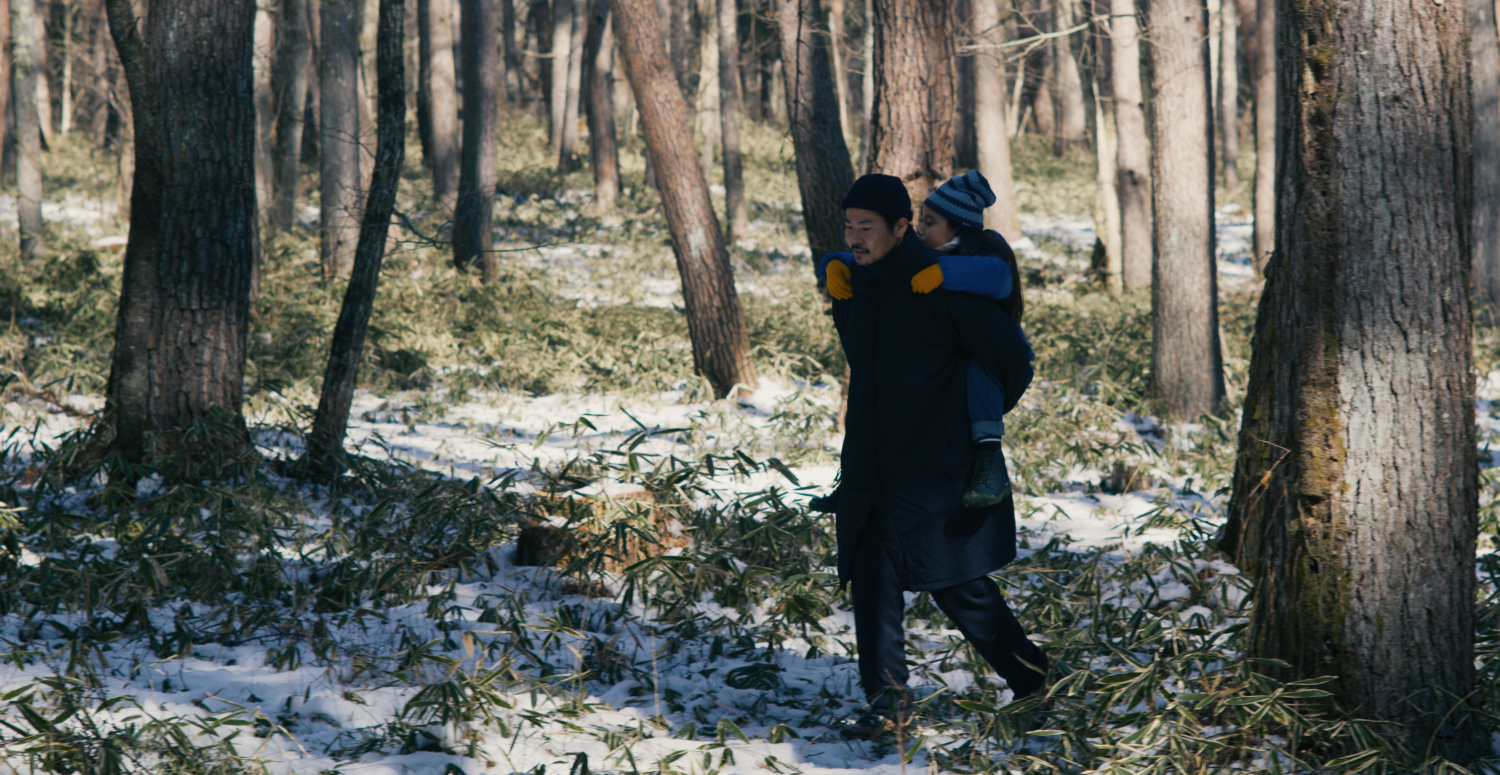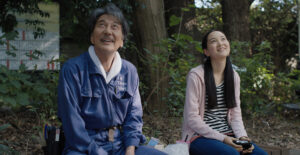Le mal n’existe pas
悪は存在しない – Aku wa sonzai shinai
(Evil does not exist)
Lion d’Argent Grand Prix du Jury – Venise
Best Film – Londres
Best Film – Kerala
Best Film – Asian Awards
2024

FR EN
Avec l’une des plus belles affiches de l’année, le nouveau film de Ryūsuke Hamaguchi à qui l’on doit notamment les films « Senses », « Contes du hasard et autres fantaisies » et « Drive my car », se distingue évidemment pour ses qualités contemplatives avec ses plans picturaux, mais aussi pour sa fin énigmatique ouverte aux interprétations.
Primé à Berlin, à Cannes, aux Oscars et maintenant à Venise pour ce nouveau film qui repart de la Mostra 2023 avec un Lion d’Argent pour le Grand Prix du jury, le cinéaste japonais signe une nouvelle fois une œuvre singulière qui percute les genres et nous offre un voyage à travers un écosystème – naturel, métaphorique, ou narratif … « Le mal n’existe pas » est en quelque sorte un poème symphonique à la conclusion dissonante car le champ lexical musical est ici primordial tant les compositions d’Eiko Ishibashi sont au cœur de ce film né de la collaboration entre la compositrice japonaise et le cinéaste sur un concert accompagné d’images muettes. Ce long-métrage réutilise ainsi la matière musicale et visuelle de leur précédent projet. Ici, la musique précède donc l’intrigue de cette expérience cinématographique à voir comme un voyage sensoriel plus que comme une pure fable écologique ou métaphysique.
La singularité de l’œuvre est de ce fait, notamment portée par l’indépendance de sa musique avec ses ruptures de ton et de rythme. Les coupes brusques dans sa partition ou au montage de certaines scènes servent ainsi d’avertissement implicite : le climat peut être trompeur, tout a une fin, et parfois brutale. Derrière ses somptueuses images et son esthétique paisible, « Le mal n’existe pas » porte donc une violence enfouie, sèche, imprévisible à l’image du silence de deuil ou du passé entourant le protagoniste, ou des coupes musicales, ou encore des coups de feu sporadiques. Beauté et douceur y cohabitent avec l’imminence du danger !
Le film s’ouvre sur ce qui s’apparente plus à une ouverture de concert qu’à une introduction avec son long travelling vers le ciel à travers la cime des arbres installant à la fois le rythme si particulier du film et son cadre naturel. La caméra contemplative semble alors murmurer avec le vent, frémir avec les arbres, ou s’écouler avec l’eau pure de la rivière. Et cela demande du temps et donc des plans, souvent fixes, qui s’attardent. Tout le premier quart du film se limite ainsi à une exploration minutieuse des lieux, presque sans dialogues. Cette lenteur rend même les conversations les plus banales, significatives et la mise en scène plus expressive. Un long travelling latéral observe par exemple à distance le protagoniste marchant dans une forêt enneigée puis disparaître derrière un talus pour réapparaître avec sa fille sur son dos, synthétisant ainsi la parfaite harmonie du duo familial dans son environnement.
Le rythme et la précision de la mise en scène nous font rentrer dans le cadre pour y déceler les moindres détails, car ce sont eux, ainsi que les motifs établis et le ressenti des scènes qui comptent plus que l’intrigue. Comme dans ses précédents films, bien que ce soit dans une plus faible mesure que dans « Drive my car » par exemple, Hamaguchi crée une relation avec le spectateur via sa mise en scène. Il instaure un cadre, des codes, des motifs, bref une syntaxe pour y déceler des clés de lecture en fonction des choix de cadrage, de musique ou autres. Le dernier plan vient ainsi boucler la boucle avec une répétition du traveling d’introduction dont les éléments scénographiques sont alors inversés par le basculement de l’histoire.
Mettant en scène un père et sa fille, c’est l’histoire d’un modeste homme à tout faire – joué par un remarquable acteur non professionnel – d’une communauté rurale non loin de Tokyo et fin connaisseur de la région qui se retrouve menacée par un projet de camping luxueux. L’équilibre des lieux est ainsi mis en danger par des urbains au bout du rouleau, inconscients du bouleversement qu’ils vont provoquer …
Le film ne peut toutefois pas se résumer à cette opposition entre urbain et rural car ce point de départ est vite dépassé à la faveur d’une réflexion globale sur nos rapports à la nature et aux autres. C’est une histoire d’équilibre, il y est question d’harmonie, du vivre-ensemble, et de sa fragilité. Au cœur du récit se trouve une rupture d’équilibre, aussi bien social que naturel, mais à l’échelle intime. Le mal du titre vient-il alors de la ville ou de la nature ? Cette confrontation initiale est rapidement dissoute en plaçant les personnages du même côté, donnant un premier éclairage sur le titre avant d’être contrebalancé par un récit mystérieux, poétique et polysémique jusqu’à sa conclusion.
Une conclusion on ne peut plus énigmatique dont l’issue sèche et dont la signification obsède longtemps après le générique de fin. Surprenant, déroutant et frappant, le dénouement fait ainsi basculer la dynamique du film et reste grand ouvert à l’interprétation. Moins fort et émouvant que ses précédents, ce nouveau film d’Hamaguchi déjoue nos attentes et confirme néanmoins ses talents de metteur en scène aussi bien sur la forme que le fond.
With one of the most beautiful posters of the year, the new film by Ryūsuke Hamaguchi, whose credits include “Senses”, “Wheel of Fortune and Fantasy” and “Drive my car”, stands out not only for its contemplative nature with its pictorial shots, but also for its enigmatic ending left open to interpretation.
Winner of awards in Berlin, Cannes, the Oscars and now Venice for this new film, which takes home the Silver Lion for the Grand Jury Prize at the 2023 Mostra, the Japanese filmmaker has once again delivered a singular work that collides genres and takes us on a journey through an ecosystem – whether natural, metaphorical or narrative… “Evil does not exist” is in a way a tone poem with a atonal conclusion, as the musical lexicon is of paramount importance here, since Eiko Ishibashi’s compositions are at the heart of this film, born of the collaboration between the Japanese composer and the filmmaker on a concert featuring silent images. This feature film draws on the musical and visual material of their previous project. Here, the music precedes the plot of this cinematic experience, which is more a sensory journey than a purely ecological or metaphysical tale.
The film’s singularity is therefore driven by the independence of its music, with its breaks in tone and rhythm. The sudden cuts in its score or in the editing of certain scenes offer an implicit warning: the mood can be deceitful, everything has an end, and sometimes a brutal one. Behind its gorgeous images and peaceful aesthetic, “Evil does not exist” conveys a buried, dry, unpredictable violence, like the silence of mourning or the past surrounding the protagonist, as well as the musical cuts or sporadic gunshots. Beauty and tenderness coexist here with the imminence of danger!
The film opens with something more of an overture than an introduction, with a long tracking shot into the sky through the treetops, setting both the film’s distinctive pace and its natural setting. The contemplative camera then seems to whisper with the wind, quiver with the trees, or flow with the pure water of the river. And this requires time, and therefore lingering, often still shots. The entire first quarter of the film is in fact devoted to a meticulous exploration of the surroundings, with almost no dialogue. This slowness makes even the most banal conversations meaningful, and the staging more meaningful. A long lateral tracking shot, for example, watches from a distance as the protagonist walks through a snowy forest, then disappears behind a hillside only to reappear with his daughter on his back, thereby encapsulating the perfect harmony of the family duo in their environment.
The pace and precision of the direction draw us into the frame to catch the smallest details, as these, along with the set patterns and mood of the scenes, that matter more than the plot. As in his previous films, albeit to a lesser extent than in “Drive my car”, for example, Hamaguchi creates a relationship with the viewer through his mise en scène. He creates a framework, codes, patterns – in short, a language that can be used to decipher the meaning of the film, depending on the framing, music and other choices made. The final shot thus brings the story full circle, repeating the opening tracking shot, though its scenographic features are inverted by the story’s dramatic shift.
Featuring a father and daughter, this is the story of a modest handyman – played by a remarkable non-professional actor – from a rural community not far from Tokyo, and a fine connoisseur of the area, that finds itself threatened by a fancy camping project. The balance of the area is thereby threatened by city dwellers at the end of their tether, oblivious to the upheaval they are about to cause…
However, the film cannot be summed up in this opposition between urban and rural, as this starting point is quickly transcended in favor of a global reflection on our relationship with nature and with others. It’s a story of balance, of harmony, of living together, and of its fragility. At the heart of the story lies a disruption of balance, both social and natural, but on the intimate scale. Does the evil of the title come from the city or from nature? This initial conflict is quickly fade away by putting the characters on the same side, shedding some light on the title before being counterbalanced by a mysterious, poetic and polysemic narrative right up to its finale.
This is a highly enigmatic and gripping ending whose meaning haunts long after the credits have rolled. Surprising, disconcerting and striking, the conclusion reverses the axis of the film, leaving it wide open to interpretation. Less powerful and moving than his previous films, Hamaguchi’s latest nevertheless foils our expectations, and confirms his mastery of both style and substance.

